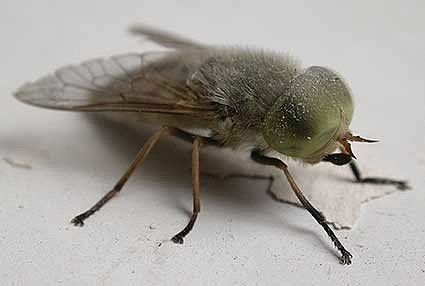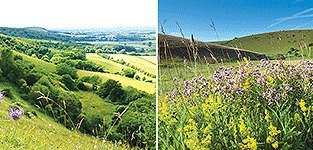Sussex Wildlife Trust: Mother nature bites back - horseflies
September 4th, 2018 On hot, calm days horseflies launch an airborne offensive against us, using some impressive aerial manoeuvres which have been compared to the ‘Immelmann Turn’ perfected by WWI fighter pilots.
On hot, calm days horseflies launch an airborne offensive against us, using some impressive aerial manoeuvres which have been compared to the ‘Immelmann Turn’ perfected by WWI fighter pilots. For centuries man has waged war on wildlife. Apart from destroying its home we’ve systematically killed it for food, fashion or fun. It seems we’re winning. There isn’t much wildlife left, which isn’t surprising as nature really hasn’t been retaliating. Sure, you may occasionally get pooed on from above or find a hole in an old jumper but overall the battle has been rather one-sided. Yet within nature there lie certain extremist factions whose sole purpose, it seems, is to make us pay in blood for our crimes. Leading the insect axis of evil are nature’s most tenacious terrorists; horseflies.
On hot, calm days horseflies launch an airborne offensive against us, using some impressive aerial manoeuvres which have been compared to the ‘Immelmann Turn’ perfected by WWI fighter pilots. Different species target different parts of the body. Imagine a moustachioed horsefly Squadron Leader rapping his baton against a map of the human anatomy and co-ordinating the assault. “Tabanus and Atylotus, you fly in low for a bally bite behind the knees. Haemotopata, aim for the wrists. Chrysops – sneak up from the rear and go for the neck.”
Of course vengeance isn’t the real motivation for these attacks. In a darkly delicious twist it turns out that we humans each have a resource that horseflies would like to exploit. Eight pints of it in fact. In order for their eggs to develop, female horseflies require a small snack of mammalian blood.
Most horseflies target the hardened hides of horses, deer, cattle and sheep, so thin-skinned Sussex hikers are fast food for the fly. Whereas mosquitoes silently siphon our sanguine syrup with the precision of a phlebotomist, horseflies perform a tactless transfusion with their stout, dagger-like stylets. To prevent the blood clotting she squirts in saliva (it’s this alien anticoagulant which causes itching and swelling) and slurps up our body’s natural resources. You’ve been fracked!
It’s hard to love a horsefly but look your enemy in the eye and you will see one of nature’s most amazing sights, a psychedelic swirl of pixelated patterns. True beauty. But this probably won’t endear them to you as you’re slapping, swatting and swearing on the South Downs. 2018 has been a good year for the biters and a bad year for the bitten. Horsefly larvae develop in wet conditions and the high rainfall in the spring created plenty of perfect habitat. I get bitten yet I find it hard to grumble. I get so much free pleasure from watching the natural world (not to mention all that water, food and air too). Call me a traitor but if the occasional drop of blood is the price I have to pay then I’m happy to donate to their cause. Viva la resistance!
Sussex Wildlife Trust is an independent charity caring for wildlife and habitats throughout Sussex. Founded in 1961, we have worked with local people for over half a century to make Sussex richer in wildlife.
We rely on the support of our members to help protect our rich natural heritage. Please consider supporting our work. As a member you will be invited to join Michael Blencowe on our regular wildlife walks and also enjoy free events, discounts on wildlife courses, Wildlife magazine and our Sussex guide book, Discovering Wildlife. It’s easy to join online at www.sussexwildlifetrust.org.uk/join or over the phone on 01273 497532.
by Michael Blencowe of the Sussex Wildlife Trust
www.sussexwildlifetrust.org.uk drop a snippet from the panel on the right.
On hot, calm days horseflies launch an airborne offensive against us, using some impressive aerial manoeuvres which have been compared to the ‘Immelmann Turn’ perfected by WWI fighter pilots. Different species target different parts of the body. Imagine a moustachioed horsefly Squadron Leader rapping his baton against a map of the human anatomy and co-ordinating the assault. “Tabanus and Atylotus, you fly in low for a bally bite behind the knees. Haemotopata, aim for the wrists. Chrysops – sneak up from the rear and go for the neck.”
Of course vengeance isn’t the real motivation for these attacks. In a darkly delicious twist it turns out that we humans each have a resource that horseflies would like to exploit. Eight pints of it in fact. In order for their eggs to develop, female horseflies require a small snack of mammalian blood.
Most horseflies target the hardened hides of horses, deer, cattle and sheep, so thin-skinned Sussex hikers are fast food for the fly. Whereas mosquitoes silently siphon our sanguine syrup with the precision of a phlebotomist, horseflies perform a tactless transfusion with their stout, dagger-like stylets. To prevent the blood clotting she squirts in saliva (it’s this alien anticoagulant which causes itching and swelling) and slurps up our body’s natural resources. You’ve been fracked!
It’s hard to love a horsefly but look your enemy in the eye and you will see one of nature’s most amazing sights, a psychedelic swirl of pixelated patterns. True beauty. But this probably won’t endear them to you as you’re slapping, swatting and swearing on the South Downs. 2018 has been a good year for the biters and a bad year for the bitten. Horsefly larvae develop in wet conditions and the high rainfall in the spring created plenty of perfect habitat. I get bitten yet I find it hard to grumble. I get so much free pleasure from watching the natural world (not to mention all that water, food and air too). Call me a traitor but if the occasional drop of blood is the price I have to pay then I’m happy to donate to their cause. Viva la resistance!
Sussex Wildlife Trust is an independent charity caring for wildlife and habitats throughout Sussex. Founded in 1961, we have worked with local people for over half a century to make Sussex richer in wildlife.
We rely on the support of our members to help protect our rich natural heritage. Please consider supporting our work. As a member you will be invited to join Michael Blencowe on our regular wildlife walks and also enjoy free events, discounts on wildlife courses, Wildlife magazine and our Sussex guide book, Discovering Wildlife. It’s easy to join online at www.sussexwildlifetrust.org.uk/join or over the phone on 01273 497532.
by Michael Blencowe of the Sussex Wildlife Trust
www.sussexwildlifetrust.org.uk drop a snippet from the panel on the right.
Comments (0)
No comments have been submitted yet.Why not be the first to send us your thoughts
Leave A Comment
Thank you for your comments, they will appear shortly once approved.
Recent Posts
Have You Seen...






